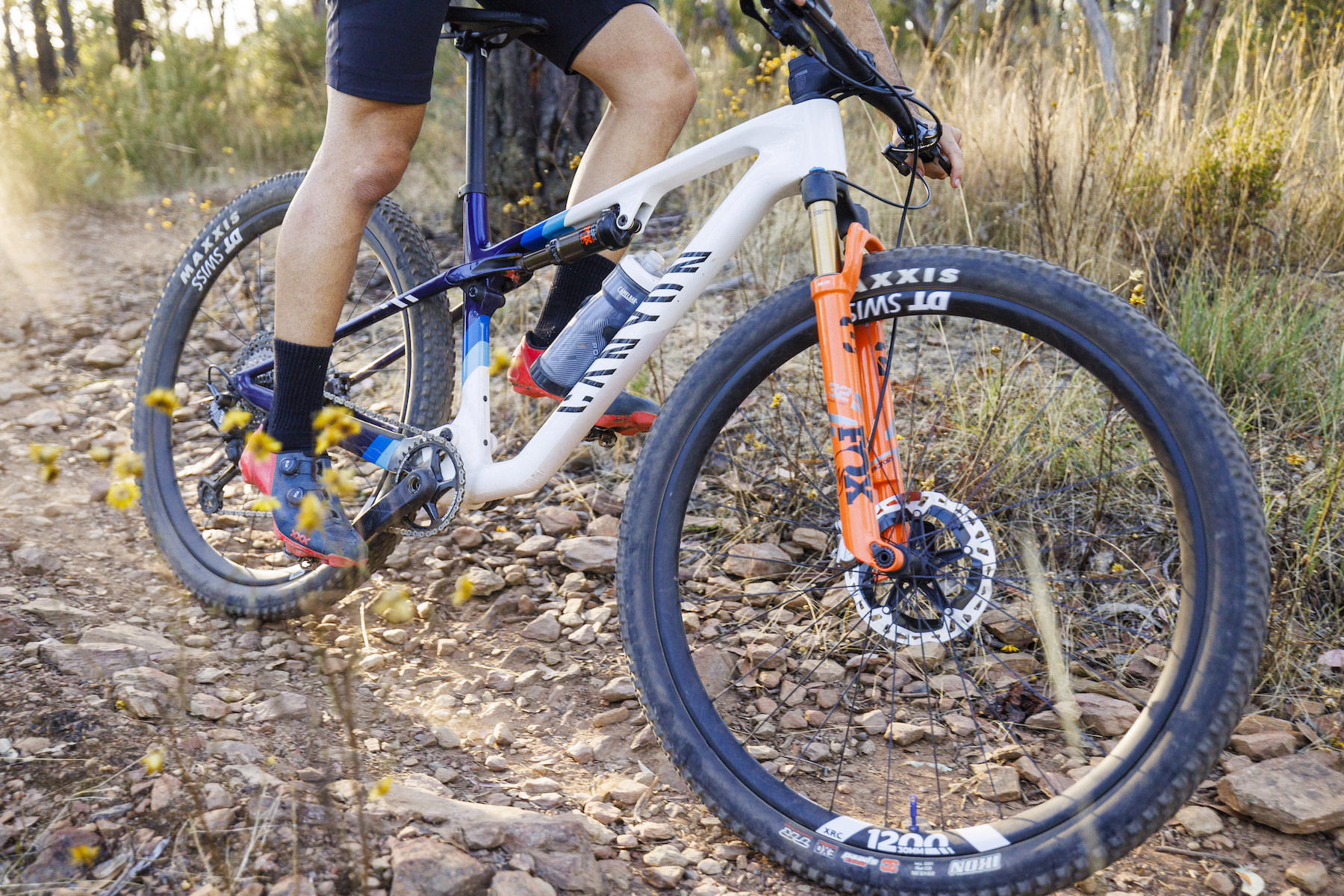Wil reviews & rates the best XC mountain bikes
Over the past five years I’ve been working at Flow, I’ve had the chance to review some of the best cross country mountain bikes on the market. From the strikingly svelte Trek Supercaliber, to the plush ‘n’ progressive Merida Ninety-Six, to the lethally lightweight Specialized Epic World Cup, we’ve tested some absolutely incredible full suspension race machines.
While all of these bikes possess their own unique strengths, quirks and on-trail personalities, together they represent a broader evolution in the sport of XC as a whole. As race courses become more technical and demanding, we’ve seen the widespread adoption of dropper posts, wider handlebars and more powerful brakes, which have helped to elevate rider confidence and control. Frame designers are employing wider chainlines to accept bigger tyres, and head angles are getting slacker to improve high-speed stability. And in the case of bikes like the Orbea Oiz, Scott Spark and Specialized Epic 8, we’re also seeing notable increases in suspension travel to deliver more traction and comfort on rougher trails.

Not only have all these improvements allowed elite athletes to ride faster and harder than ever before, they’ve also made the premise of owning a shorter travel bike all the more appealing for everyday riders. Indeed modern XC bikes are no longer the horribly dainty, overly-twitchy, crash-fests of old. Far from it. A lot of them are actually — dare we say it — fun to ride. In most cases they’re surprisingly versatile too. Many possess the ability to accommodate a longer stroke shock and a bigger fork that allows them to morph into a lightweight trail bike.
That’s all well and good, but out of all the snazzy new models we’ve been testing, which is the best? Here we’ll be taking you through the top 13 full suspension XC bikes we’ve tested, what’s impressed us, what hasn’t, and which gets our pick out of the lot.

Specialized Epic 8
- Highs: Active suspension, clever custom-tuned fork & shock, contemporary geometry, SWAT storage, lightweight & practical frame design
- Lows: S-Works model is eye-poppingly expensive, SRAM Level brakes, no alloy models
The Specialized Epic has been one of the most well-known XC bikes on the circuit since its introduction back in 2002. Built around the distinctive Brain shock, the Epic was infamous for its automated hardtail-like efficiency. The proprietary inertia valve added weight and complexity however, and it also made for quite a demanding ride quality across rough terrain.
For 2024 the Epic has received its most significant evolution yet. Not only has Specialized ditched the Brain entirely, it’s also increased suspension travel to 120mm front and rear. Combined with progressive XC geometry and an adjustable Hi/Lo flip chip, the Epic 8 is a vastly plusher and more capable descender compared to its predecessor.
It’s still quick up the climbs too thanks to its lightweight frame and clever 3-position suspension system. Featuring custom internals courtesy of RockShox, the SID fork and SIDLuxe shock offer open and lock modes, as well as an in-between Magic Middle setting that delivers a satisfyingly pert pedalling platform.
Most of the Epic models come with a TwistLoc remote to switch between the three suspension modes, though the flagship S-Works model does it automatically with the latest RockShox Flight Attendant system. It comes with a stupendously high sticker price to match, but it’s no doubt the performance benchmark when it comes to XC suspension.
There are loads of other neat features to be found on the new Epic 8 including SWAT downtube storage, a hidden steering limiter and guided internal cable routing. See our in-depth Specialized Epic 8 review for the rundown.

Specialized Epic EVO
- Highs: Impeccable handling, smooth & capable suspension, trail-ready build kit, SWAT storage, mechanic-friendly frame furnishings
- Lows: Fox shock and dropper post issues, high starting price, no alloy models
Alongside the Epic 8 race bike, the Specialized Epic EVO is a brand new XC bike for 2024. It’s built around the same full carbon frame that features SWAT storage, a Hi/Lo geometry flip chip, threaded BB and guided internal cable routing. It also features 120mm of rear travel, but up front you’ll find a bigger 130mm travel Fox 34.
To further boost its trail credentials, Specialized gives the Epic EVO more powerful brakes, grippier tyres, and a longer stroke dropper post. The riding position is also more relaxed thanks to a shorter stem and wider handlebar.
All of that result in quite a different feel out on the trail, with the Epic EVO offering a plusher ride quality and more confidence when charging rough descents. Indeed it is remarkably capable for a 130/120mm travel bike.
The burlier component package does mean the Epic EVO is heavier, and along with the chunkier tyres it doesn’t zip up the climbs quite as effortlessly as the Epic 8 race bike. The lack of a remote lockout will also make it a turnoff to racer types.
If you’re not so serious about racing however, the Epic EVO is undoubtedly one of the most fun and capable XC bikes out there. Check out our Specialized Epic EVO review for more.

Canyon Lux Trail
- Highs: Great suspension, naturally efficient, crisp handling, clever storage solutions, top value spec throughout the range
- Lows: Not the most forgiving ride, cockpit ergonomics could be better, messy cable routing
The Canyon Lux Trail first arrived in 2021 as a slightly longer travel offshoot of the Lux race bike. To keep the costs down the two models shared an identical rear end, with the Lux Trail adopting a unique front triangle that was notably slacker and longer. Along with a 120mm travel fork and a more practical build kit, it was a clever and relatively inexpensive way to add another model to the lineup. Still, it wasn’t exactly perfect.
Addressing our previous criticisms, Canyon totally overhauled the Lux Trail for 2024. Featuring a brand new carbon frame, the Lux Trail is equipped with a 120mm travel fork and 115mm of rear travel. It’s also the first Canyon mountain bike to feature internal storage. The hatch is well executed too, and we like the optional multi-tool that sits in a dedicated mount underneath the top tube.
The practical approach extends to the threaded BB and tool-free thru-axles, but not quite to the cable routing. The main control lines pass through the headset, making for quite the nest in front of the bars. Given how efficient the Lux Trail is, we reckon Canyon could have easily ditched the remote lockout in favour of a tidier setup and better ergonomics for the dropper post lever.
Those complaints aside, the Lux Trail is a fantastic performer out on the trail. It is heavier than the Lux World Cup, but it’s still terrifically agile through twisty singletrack. You can also push it a lot harder on the descents thanks to the smoother suspension and long-stroke dropper post, making it a load of fun to ride on technical terrain. See the full story in our Canyon Lux Trail review.

Cervelo ZFS-5
- Highs: Beautifully smooth ride quality, plush & poppy suspension, lightweight but practical frame, superb spec package
- Lows: 100mm XC builds don’t come with a dropper post, headset cable routing may be a turn off for some
Although the ZFS-5 is Cervelo’s first ever full suspension mountain bike, the roadie brand was able to get a solid head start by drawing on the valuable experience of its sister brand Santa Cruz.
Indeed the ZFS-5 shares much of its DNA with the Blur, though it’s worth noting that they are two separate bikes. The ZFS-5 has been built around its own unique carbon frame that’s claimed to be one of the lightest on the market at just 1,718g. It also features different geometry with our test bike sporting a devilishly slack 66.6° head angle.
You can get the ZFS-5 in two distinct flavours. There’s a flat-out XC race bike with 100/100mm of travel, and a more versatile trail bike with 120/115mm of travel. The frame is identical between the two, with a longer-stroke shock and fork switching up the vibe.
Even in its longer travel guise, we found the ZFS-5 to offer neutral pedalling performance that responds surprisingly well to hard efforts. The lithe chassis makes it a pleasure to climb with, and the modern geometry means it’s terrifically well-balanced across a variety of trail types. Add in the excellent build package along with the plush and poppy suspension, and you’ve got an absolutely ripping XC bike that’s a whole lot of fun to ride. See our Cervelo ZFS-5 review for everything you need to know.

Trek Supercaliber
- Highs: Striking frame design, powerful pedalling performance, responsive handling, contemporary build kit
- Lows: Short travel is less forgiving on really rough trails, shock servicing and tuning are more involved, expensive
Easily one of the most striking XC bikes on the market, the Trek Supercaliber has been completely redesigned for 2023. Trek has introduced two new frames that feature updated geometry, an increase in travel and a totally new IsoStrut shock that’s now manufactured by RockShox instead of Fox.
You’ll still find the distinctive IsoStrut suspension platform out back, though rear travel has been increased to 80mm to provide more grip and comfort. Despite this, the Supercaliber retains its incredible pedalling efficiency thanks to a higher main pivot that boosts anti-squat. There’s a dual remote lockout at the handlebar, but it’s really not necessary for the rear suspension since it’s so responsive under power.
Descending performance has also improved due to a slacker 67.5° head angle, a longer wheelbase, and a 110mm travel fork. Almost every Supercaliber model comes standard with 2.4in tyres and a dropper post too, which is fantastic to see.
It’s still not the most forgiving bike on really rough terrain, especially compared to 120mm travel bikes like the Spark and Oiz. I also wasn’t impressed with the cockpit ergonomics on our SLR 9.8 GX AXS test bike, and the nest of cables in front of the handlebar is messy compared to the much cleaner Epic World Cup.
There’s no denying its razor-sharp handling and explosive pedalling performance however, which successfully splits the difference between a hardtail and traditional full suspension bike. Check out our Trek Supercaliber review for the full story.

Orbea Oiz
- Highs: Lightweight and elegant frame design, superb geometry, plush and on-the-fly adaptable suspension, lots of spec options including alloy models
- Lows: Headset cable routing, not the quietest bike, limited clearance for 2nd bottle
Whereas the previous Orbea Oiz was available in both 100mm and 120mm travel variants that utilised the same chassis, the latest Oiz is now purpose-built around 120mm of travel front and rear. This commitment has allowed Orbea to optimise the geometry and bring it right up to date. Along with the increased travel and the fact that it comes with 2.4in tyres and a dropper post as standard, the Oiz is one of the most fun and capable XC bikes out there.
It’s still incredibly light, with the top-end OMX carbon frame claimed to weigh just 1,750g including the shock. It’s also impressively quick up the climbs thanks to its efficient pedalling manners and remote-activated suspension.
The Squidlock remote isn’t perfect, though it is plenty functional with the Medium suspension mode firming up the rear shock’s damping while leaving the fork entirely open. This helps to steepen the angles and lift the BB, providing a terrific technical climbing mode that maintains front-end compliance over rocky and rooty terrain. It also sharpens up the steering when you’re speeding along flowy singletrack. If you’re keen to know how it rides, see our full Orbea Oiz review.
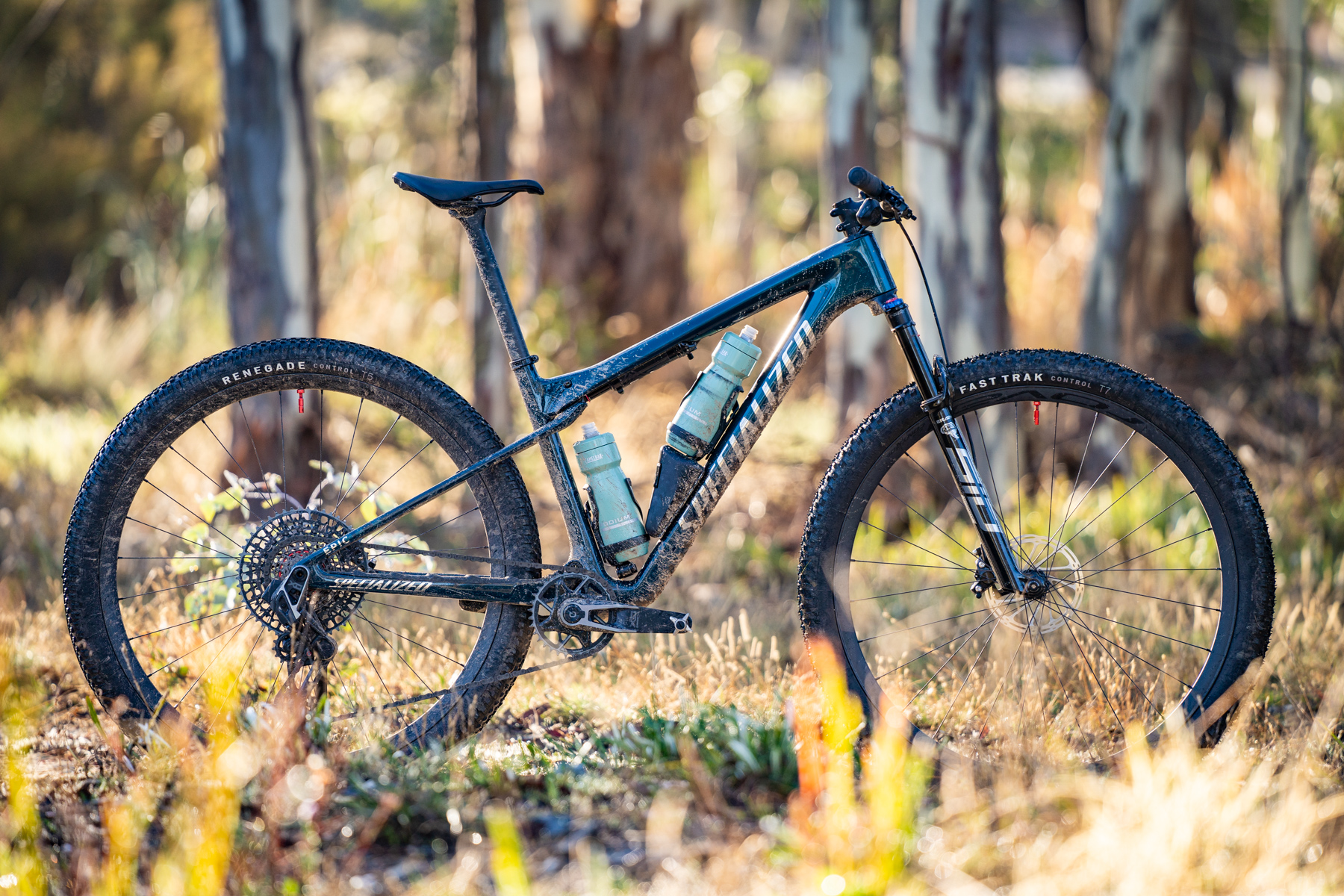
Specialized Epic World Cup
- Highs: Exceptional automated efficiency, superb geometry, tuneable shock, clutter-free cockpit, very lightweight, dual bottle ready
- Lows: Ride can be unrelenting when not at race pace, Brain fork is jarring on rocky terrain, proprietary shock is yet to be proven in the mass market, expensive
A brand new model for 2023, the Specialized Epic World Cup is the result of a 4-year project to build the ultimate XC race bike that combines the responsiveness of a hardtail, with the big-hit control of a conventional full suspension bike.
To achieve this lofty goal, Specialized ditched the Brain damper and collaborated with RockShox to build a new SIDLuxe WCID shock. Instead of an inertia valve, the new shock utilises a clever air spring design that allows you to tune the negative chamber independently of the positive spring. The result is a tuneable package that delivers hardtail-like acceleration in its firmest setting.
The proprietary shock delivers just 75mm of rear travel, and that’s paired to a custom RockShox SID SL fork with 110mm of travel and an updated Brain damper. It’s all built around a new carbon fibre chassis that is claimed to be one of the lightest on the market.
While rear travel is conservative, geometry is very progressive with a 66.5° head angle and a hefty 58mm BB drop. It all adds up to create a responsive and highly involving bike to ride, though one that prefers to be pushed hard and fast to get the most out of it. With this in mind, riders who prefer a plusher ride quality and are after a more versatile XC bike will be better off looking at the longer travel Epic EVO.
But if you value outright efficiency, the Epic World Cup is one of the best on the market while offering a stupendously clean cockpit with no lockout to worry about. Get the full story in our Specialized Epic World Cup review.
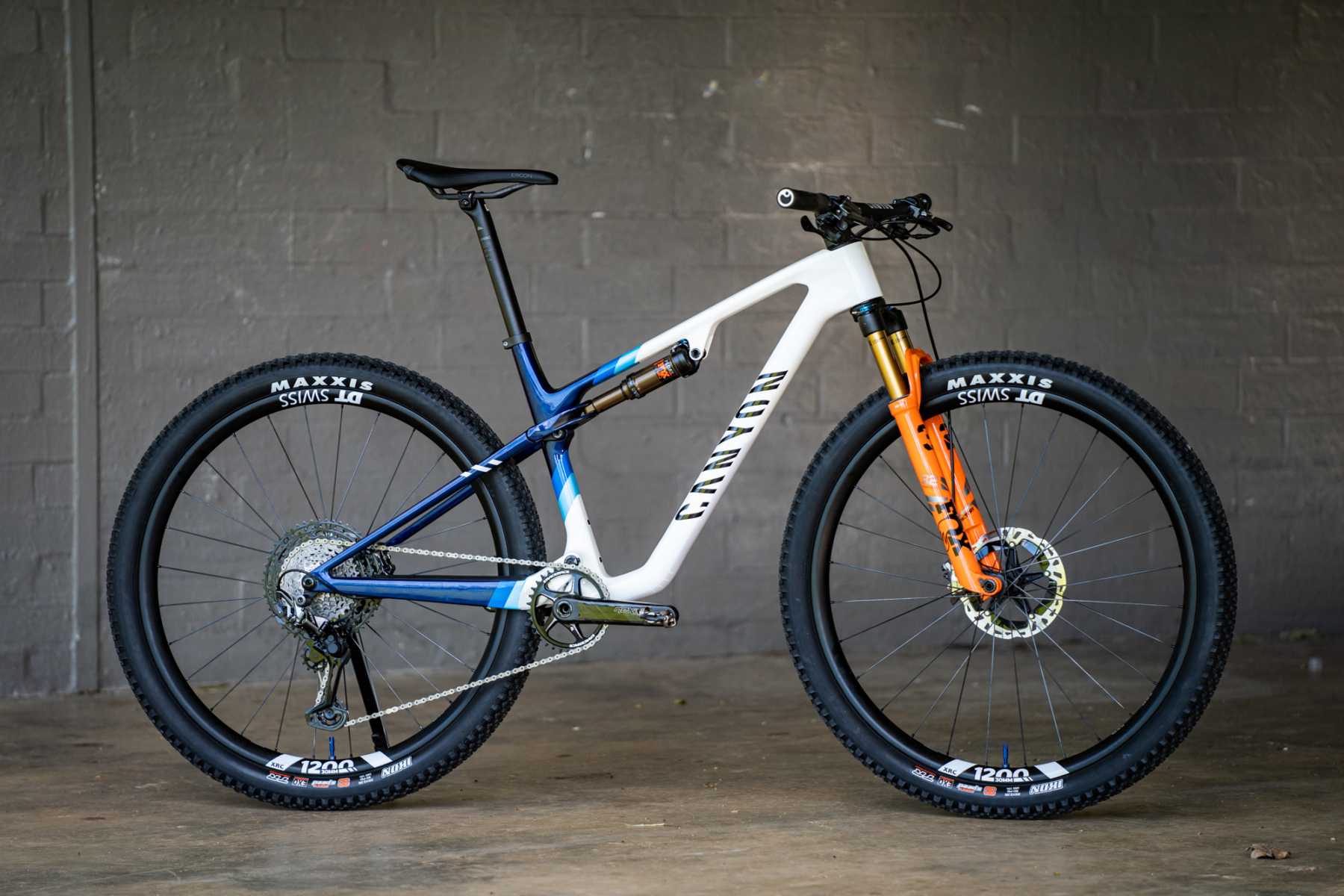
Canyon Lux World Cup
- Highs: Organic pedal efficiency, precise handling, high-tech bearings, dual bottle ready, very appealing spec for the money
- Lows: Racy suspension feel won’t suit all tastes, headset cable routing, fork feels under-gunned, no dropper
Sitting alongside the slightly longer travel Lux Trail, the Canyon Lux World Cup is the purebred race machine of the two. It’s equipped with 100mm of travel and a new carbon frame that Canyon claims to be one of the lightest on the market.
The updated geometry has paid dividends on the trail, with the Lux World Cup offering improved balance and stability at speed over its predecessor. It ties in well with its race-tuned chassis and suspension, which provides outstanding pedal efficiency and responsive handling through tight singletrack.
Given how hard you can push the stout frame, the Fox 32 SC does feel somewhat under-gunned up front. We’re also surprised that Canyon doesn’t offer any of the Lux World Cup models with a dropper post. Combined with the firm suspension tune, the Lux World Cup isn’t as plush or as confidence-inspiring on rough terrain as more contemporary bikes like the Scott Spark or Merida Ninety-Six.
With that in mind, those chasing more of an XC all-rounder should check out the Lux Trail instead. If you’re after a lightweight, agile and deadly efficient race bike though, you’d be hard pressed to find anything that packs in the same level of features and spec for the money as this. See our Canyon Lux World Cup review for the lowdown on the stock bike, though if you’re curious about what’s possible with a few spec changes, check out my long-term review for a deep-dive into the true capabilities of the Lux World Cup.
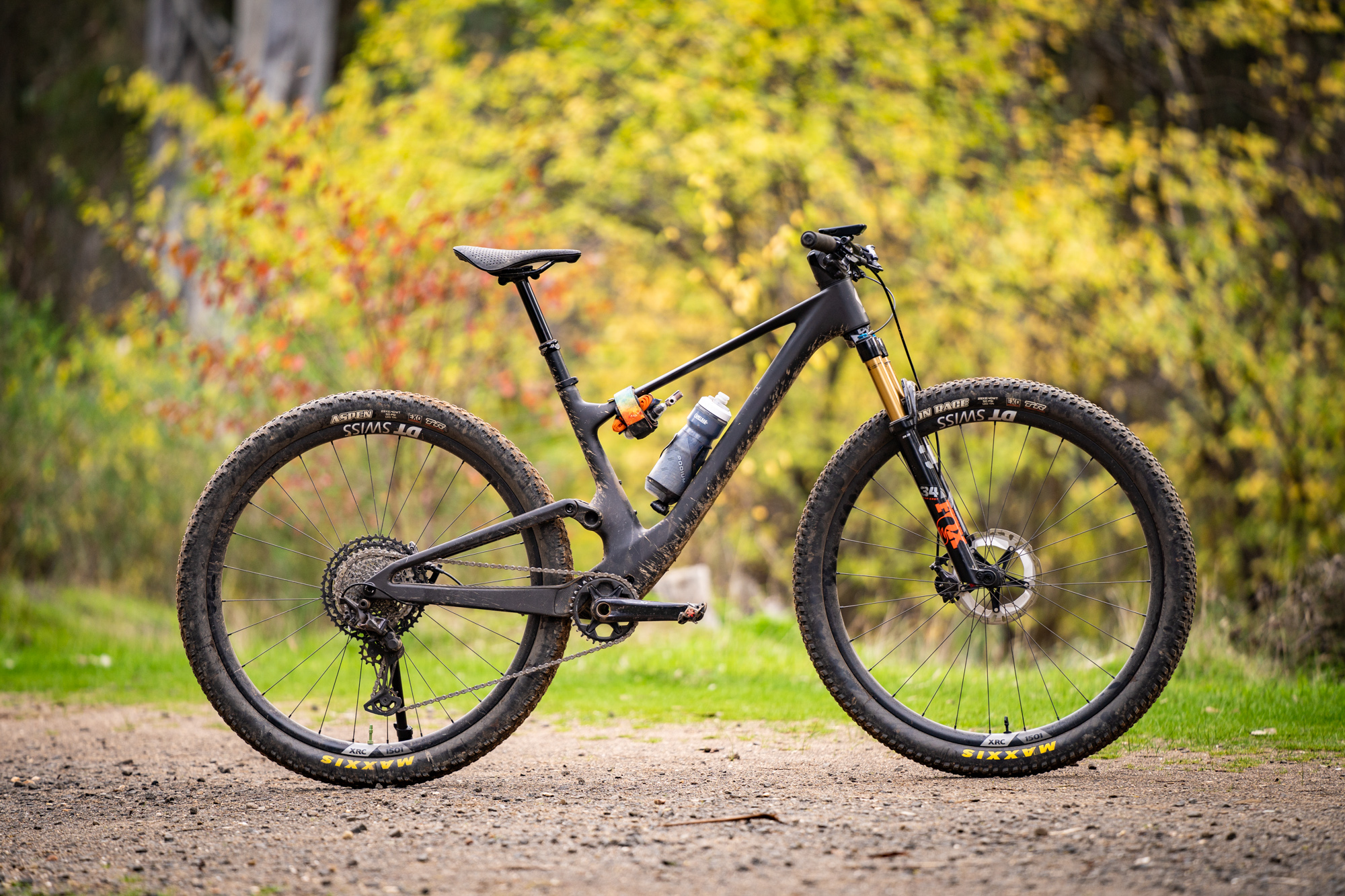
Scott Spark RC
- Highs: Progressive geometry, plush and traction-rich suspension, versatile chassis, split-personality TwinLoc system
- Lows: Reliant on remote for pedalling efficiency, headset cable routing adds maintenance frustration, noisy frame
The latest Scott Spark made quite the impression when it launched in 2021. Replacing what was perhaps the most successful XC bike on the market, the 4th generation Spark dropped jaws thanks to its high-tech carbon frame and cleverly hidden rear shock. Featuring an updated TwinLoc remote, the Spark also introduced envelope-pushing geometry with adjustable headset cups. It also pushed the envelope with its suspension, extending travel out to 120mm at both ends — a genre-defining statement for World Cup-level XC race bikes.
Despite all the advancements, the Spark still relies on a handlebar remote and two cables to control its suspension. You’ll need to use the remote a lot to get the most out of it too, since the pedalling performance is deliberately soft and drivetrain-neutral in the full travel ‘Descend’ position. If you’re not a fan of remotes, then the Spark won’t be the bike for you.
If you’re happy to flip levers though, and you can live with the internal cable routing through the headset, the Spark offers adaptable performance that makes it both a brilliant technical climber and a fun descender. The plush suspension and low-hanging BB allows you to rip through turns, providing traction and comfort in situations that can scare lesser bikes. It really is impressive, and it all adds up to create one of the most capable XC race bikes we’ve ever tested. Get the full story in our Scott Spark RC review.

Giant Anthem
- Highs: Very lightweight frame, fantastic all-round handling, updated Live Valve is brilliant for XC racing, near-faultless contemporary build kit, nice cable routing
- Lows: Our original test frame cracked, Live Valve adds complexity and clutter, single bottle only
As one of the most popular and long-standing XC bikes on the market, the Giant Anthem underwent a wholesale redesign back in 2022. Moving away from its classic Maestro suspension design in favour of a simpler single pivot arrangement, the new Anthem frame has shed a hefty amount of weight and now stands as one of the lightest options on the market.
While weight has gone down, suspension travel has gone up by 10mm. There’s now 100mm of rear travel that’s paired to 110mm travel Fox 34 SC or RockShox SID. You’ll also find a dropper post and 2.4in Maxxis WT tyres on each model, as well as longer reach measurements and a contemporary 67.5° head angle.
Though most Anthems come with a manual remote lockout, our test bike came fitted with the Fox Live Valve system. The electric wires add clutter to the cockpit, and an external battery pack protrudes from the underside of the top tube. The overall packaging also means the Anthem is one of the few new XC bikes on the market that won’t fit two bottles.
That aside we’ve been mighty impressed with the performance of the Live Valve system, which offers a smoother but still lightning-fast transition between Open and Firm settings. It’s especially advantageous for XC racing where its firm platform delivers stompable efficiency, while giving you access to plush and active suspension on the descents. No need to toggle remote lockouts, just focus on the trail ahead. To hear about our long-term experience, check out our Giant Anthem review for more.

Merida Ninety-Six RC
- Highs: New-school geometry, sensitive suspension performance, excellent spec for the money, dual bottle capability
- Lows: Not the snappiest pedaler, not officially compatible with 2.4in tyres, inconsistent TwistLoc remote, headset cable routing adds servicing complexity
The Merida Ninety-Six arrived in late 2020 with a new carbon frame, an updated suspension design and 100mm of rear travel. It’s available in two variants, with the Ninety-Six RC getting a 100mm travel fork, faster tyres and a more race-focussed build kit.
Unlike many XC bikes, the Ninety-Six features a non-proprietary rear shock, which is appealing from a long-term ownership perspective. Also appealing is the fact that you can get a Ninety-Six for less than $6K, which is almost unheard of these days in the world of carbon full suspension race bikes.
The updated frame has room for two bottles, and features a neat accessory mount underneath the top tube. The otherwise practical approach is somewhat tarnished by the use of internal routing through the headset though, which gives moisture and dirt more opportunities to penetrate the bearings. The TwistLoc remote isn’t the tidiest solution, and the unit on our test bike proved to be frustratingly inconsistent.
Thankfully there have been big improvements to the geometry and suspension performance of the Ninety-Six RC. The simple flex-stay arrangement has dropped weight, while also bolstering lateral rigidity. While hardcore hammerers may find the rear suspension to be a little sensitive under power, there’s excellent traction on offer. The progressive linkage also delivers terrific big-hit control, which in combination with the solid chassis and sorted geometry, sees the Ninety-Six RC inspiring a load of confidence on technical trails at racing speeds. See our Merida Ninety-Six RC review for everything you need to know.

Merida Ninety-Six 8000
- Highs: Poppy & playful ride quality, confidence-inspiring geometry, plush suspension, masses of traction, awesome value for money
- Lows: Aggressive rubber tempers rolling speed, not officially compatible with 2.4in tyres, headset cable routing, remote lockout adds clutter
Alongside the racier Ninety-Six RC, the standard Merida Ninety-Six models actually feature the same full carbon frame with 100mm of rear travel. Where things differ is with the fork, which increases the travel to 120mm and slackens the head angle out to 67° for improved descending stability. Along with burlier tyres and bigger brakes, the Ninety-Six 8000 amps up the capability for riding more technical terrain.
It still incorporates many of the same features that we love about the Ninety-Six RC. The frame will accommodate two bottles for proper long-distance trail rides, and we like the tiny integrated chainguide. It’s great to see Merida including a proper-length dropper post, along with a nifty multi-tool that hides underneath the saddle.
Unfortunately the same downsides also carry over, with the headset cable routing being our main bugbear. And given that Merida has the Ninety-Six RC as the race bike, we reckon it could have done without the remote lockout on the regular Ninety-Six models to help declutter the cockpit.
That doesn’t take away from the fact that the Ninety-Six 8000 is an absolutely belting ride out on the trail. The suspension is supple over small chatter and beautifully supported on bigger wallops, while the aggressive rubber delivers masses of grip on loose terrain. Paired to the stout carbon frame and slackened geometry, this bike is a lightweight pocket rocket that rides well beyond its short travel platform. Read about our experience in the Merida Ninety-Six 8000 review.

Cannondale Scalpel
- Highs: Progressive and traction-rich suspension, smooth pedalling performance, precise and plush Lefty Ocho, dual bottle option, STASH tool system
- Lows: Not the firmest bike under power, proprietary fork and PF30 BB will be a turnoff for some, no dropper post on complete bikes
As the oldest bike in our list, the latest Cannondale Scalpel arrived back in early 2020 just as the world started to implode from the Covid-19 pandemic. Representing the 8th generation of Cannondale’s flagship full suspension race bike, the Scalpel employs a novel approach for its chainstays with a solid leaf-spring section just forward of the dropouts. This allows the suspension to behave like a conventional four-bar linkage, albeit with less weight and improved lateral rigidity.
On the trail the Scalpel is impressively smooth for a 100mm travel XC race bike, delivering excellent traction and uninterrupted pedalling performance over rough terrain. It’s also nicely progressive with plenty of big-hit support, though like the Merida Ninety-Six, the sensitive rear suspension may feel a little soft to some. This can be solved by running less sag for a firmer feel, or simply using the dual lockout for out-of-the-saddle sprinting.
Long distance riders will appreciate the option to carry two bottles, and the integrated STASH tool system is excellent. Less appealing is the PF30 bottom bracket and proprietary A.I drivetrain offset.
The Lefty Ocho is equally divisive, but while the long 55mm rake results in a tight trail figure for insanely quick steering response, its needle-bearing internals and triangular slider means it is exceptionally stout and very sensitive under load. Indeed the difference was abundantly clear when we back-to-back tested it with a conventional Fox fork. Get all the details in our Cannondale Scalpel review.
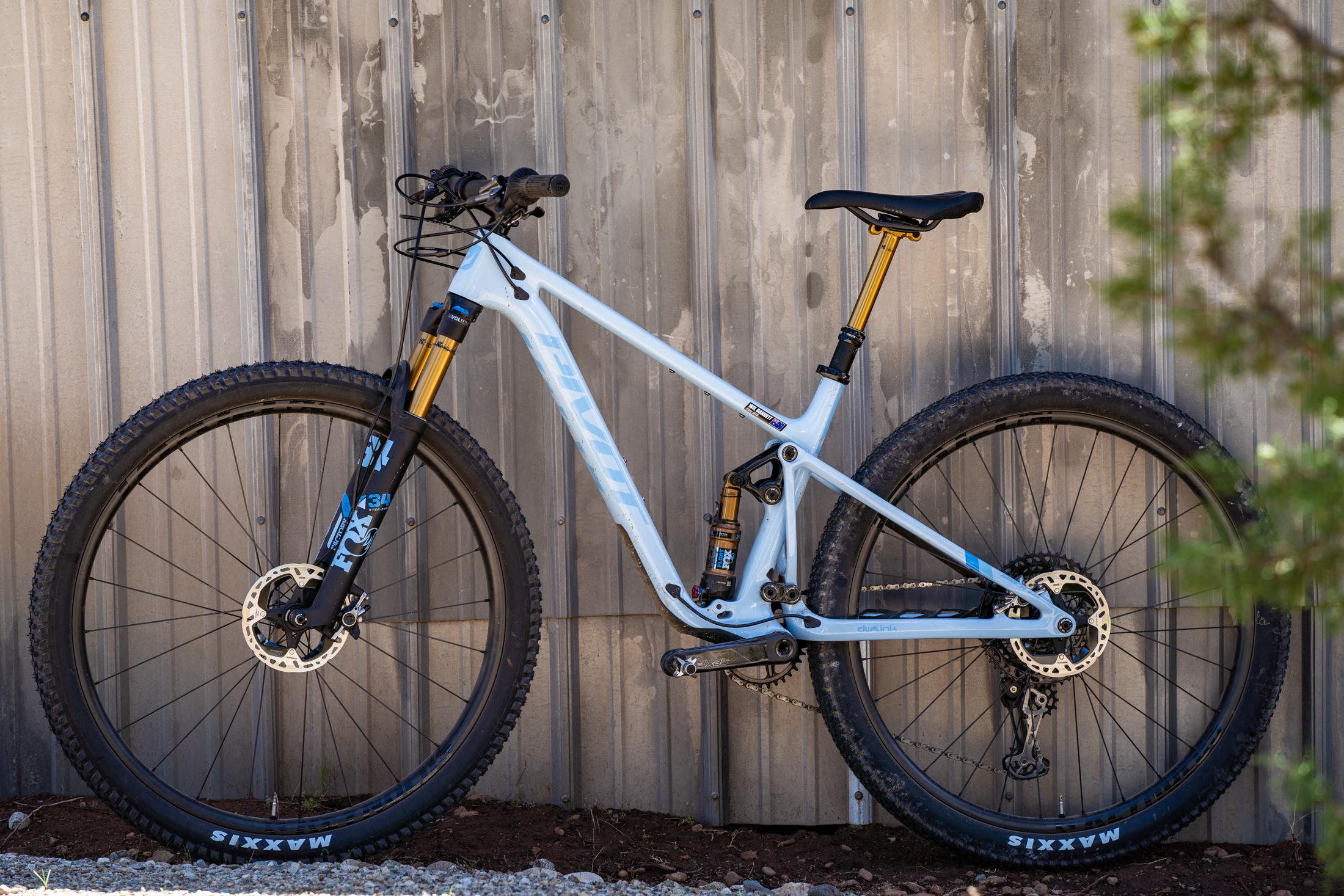
What else is out there?
Of course our XC bike group test is far from being exhaustive, as there are plenty of other full suspension race bikes on the market that we’re yet to review.
Some notable absentees include the BMC Fourstroke, Mondraker F-Podium and Ibis Exie, though these are admittedly bikes that we don’t see a lot of here in Australia. I did recently get the chance to swing a leg over the new Pivot Mach 4 SL and came away thoroughly impressed, and we’re hoping to tee up a bike locally for a proper long-term test so that I can include it in this list.
We’ll continue to add new options as and when we get our hands on them, and we’d love to hear from you about what bikes you’d like to see us review next. And if there are any brands out there reading this that want us to test out their bike, feel free to get in touch!

What’s the lightest XC bike?
Of course any discussion about XC racing wouldn’t be complete without talking about weight. For those who are hunting grams, you may be wondering; what’s the lightest XC bike out there?
In all of our bike reviews you’ll find a confirmed weight, which is taken with the tyres set up tubeless and with no pedals installed. However, since we’re not always testing bikes at the same price point (we’ll often receive whatever model is available at the time), those weights aren’t really comparable. Also, some XC bikes are still sold without a dropper post, which obviously tilts the weight balance in their favour.
For those reasons, it’s no surprise that the Canyon Lux World Cup CFR Team is the lightest XC bike in this list at 10.22kg. The heaviest bike is the 12.1kg Specialized Epic EVO Pro, though it does feature more travel, a full-length dropper post and much more aggressive tyres.
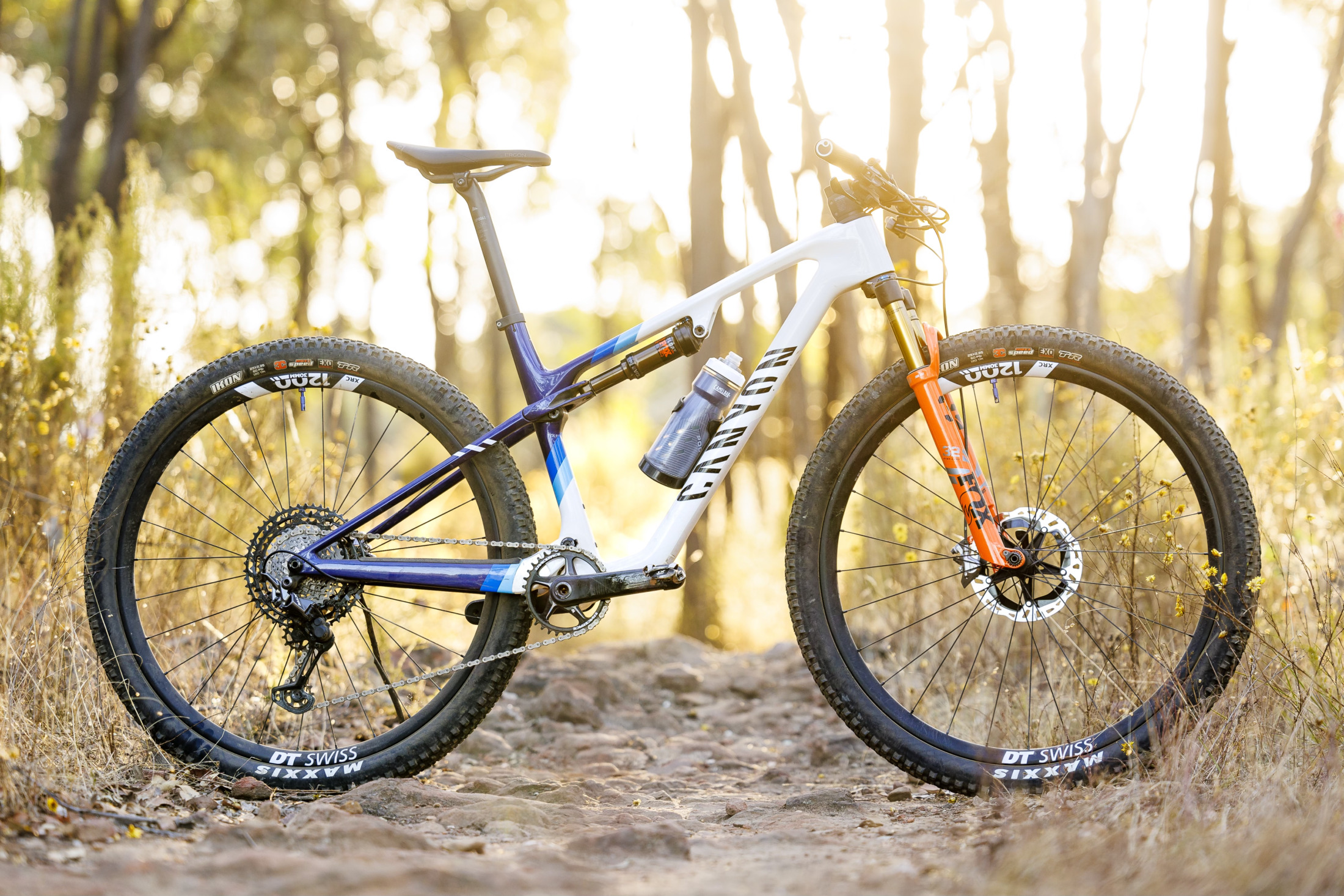
Frame weights
Where things get a little easier to compare is frame weight. Shown below are the claimed weights from each manufacturer, which is for a frame with the rear shock and basic hardware;
- Specialized S-Works Epic World Cup – 1,712g
- Cervelo ZFS-5 – 1,718g
- Giant Anthem Advanced Pro – 1,735g
- Specialized S-Works Epic 8 – 1,795g
- Orbea Oiz OMX – 1,798g
- Scott Spark HMX SL – 1,870g
- Canyon Lux World Cup CFR – 1,894g
- Cannondale Scalpel Hi-Mod – 1,910g
- Santa Cruz Blur 4 – 1,933g
- Trek Supercaliber SLR – 1,950g
- Specialized Epic EVO – 1,965g
- Merida Ninety-Six RC – 2,064g
- Pivot Mach 4 SL – 2,087g
- Canyon Lux Trail CFR – 2,104g

Coming in at just 1,712g for the S-Works frame and shock, the Specialized Epic World Cup is currently the lightest full suspension frame in our list.
However, since these claimed weights are from the manufacturers it’s important to take them with a pinch of salt. It’s not always clear whether a listed weight is for a painted frame, or even for what size. Often chainstay protectors and cable ports are omitted, and many brands regularly leave out the rear thru-axle.
As for confirmed weights, I have had the opportunity to strip a couple of test bikes down to see how close they were to the manufacturers claims. Listed below are the weights for the frame, shock and key hardware, but no thru-axle;
- Giant Anthem – 1,807g (w/Fox Float DPS)
- Canyon Lux World Cup CFR – 1,941g (w/Fox Float DPS)
- Specialized S-Works Epic 8 – 1,950g (w/RockShox SIDLuxe)
Both the Anthem and Lux World Cup are pretty close to their published figures, though the Epic 8 is 155g heavier than Specialized’s claimed weight. Part of this delta is due to the paint job on our test bike and the downtube protector, which you can read about in more detail in the S-Works Epic 8 review.

So which is the best XC bike out of the lot?
Out of the twelve options in our list, which is the best XC bike we’ve tested? Which bike should you choose?
Honestly, I’ve been impressed with the performance of all of these bikes. And really the answer to the above question is going to come down to what your priorities are.
Most efficient
For those who value maximum efficiency, the Trek Supercaliber and Specialized Epic World Cup are the most efficient XC bikes we’ve tested. These short travel specialists really are a sprinter’s dream, allowing you to forget about remote lockouts so you can concentrate on the trail ahead. I personally prefer the clean cockpit and tuneable shock on the Epic World Cup, though it’s worth noting that set up is simpler on the purposeful Supercaliber, and for many folks its dual-lockout will be a must-have. Regardless, each option does a bang-up job of splitting the difference between a hardtail and a traditional full suspension bike, albeit at a very high price.
Most versatile
If you’re after more comfort and capability, the Canyon Lux Trail, Orbea Oiz, Scott Spark and Specialized Epic EVO are no doubt the most versatile XC bikes in our list. These have all committed to bigger forks and longer travel platforms, and that gives them more grip on technical climbs, along with a smoother and calmer ride on the descents.
The Epic EVO is the burliest and heaviest of the lot, and the fact that it doesn’t have a remote lockout system will be a turn off for the racer crowd. A lighter and faster-rolling set of tyres would be an easy way to inject a bit of extra speed for the occasional event, but overall this is a bike that prioritises fun over racing. For all-round XC ripping, the Epic EVO is my pick of the bunch.
In comparison, the Lux Trail, Oiz and Spark are very much race-ready out of the box thanks to their 3-position remote suspension systems. However, they all come with highly integrated cockpits that I find less appealing from a maintenance perspective. When it comes to outright versatility, it’s the Spark that takes the cake with its adjustable head angle and the ability to fit a longer travel fork.
Best value
If it’s bang for buck you’re after, then you’d struggle to look past the Canyon Lux World Cup and Merida Ninety-Six. These are the best value XC bikes we’ve tested, offering great spec options for the money whether you want to source your new bike online through Canyon or buy a Merida from your local bike shop. On the trail these two bikes do ride quite differently, with the Lux World Cup being closer to the Supercaliber and Epic World Cup thanks to its business-like handling and efficient pedalling manners. The Ninety-Six is plusher and more progressive, giving it a fun-filled ride quality that puts it closer to the Oiz and Spark.
Best overall
The three bikes that manage to balance all of those attributes without going over-the-top with integration and proprietary components are the Giant Anthem, Cervelo ZFS-5 and Specialized Epic 8. These are all terrific examples of a modern XC bike, featuring excellent geometry and traction-seeking suspension, while also featuring some of the lightest frames on the market.

You’ll find contemporary build kits and great value for money across the Giant Anthem range, though some folks may be put off by its single bottle capacity and press-fit BB. The Cervelo ZFS-5 is more practical in that regard thanks to its well-considered frame design that’s finished to an incredibly high level. It rides beautifully too, and I particularly enjoyed testing the 120/115mm travel version. Indeed for those who aren’t fussed by remote lockouts, it’s an absolute scorcher.
The best XC bike
Just edging it out for top spot is the brilliant Specialized Epic 8. It’s a better descender with more supportive suspension, a slacker head angle and longer wheelbase, though it still scampers up technical climbs thanks to the custom-tuned RockShox dampers. The nifty SWAT storage is also really well executed and gives the Epic 8 proper all-day appeal.
Very few riders will be able to afford the flagship S-Works model, but if you can then you’ll be getting your hands on the best XC bike that money can buy. Personally I’d be looking towards the cheaper Comp or Expert models, which incorporate many of the same features at a drastically lower price point.

Flow’s Verdict
So there you have it folks – those are the top 13 best XC bikes that we’ve tested here at Flow!
As mentioned earlier, this isn’t an exhaustive list. As we test more bikes however, we’ll be adding them here so that we can compare them directly with the competition.
What this ongoing test series has made abundantly clear is that modern XC bikes are getting really bloody good. All of these bikes have impressed us in one way or another, and their unique personalities and quirks will make them appealing to different riders.
If getting a new bike isn’t in your current budget, then consider checking out our article on the top 8 upgrades for your XC bike. There may actually be a few modifications you can make to your existing bike to level-up its performance and capabilities, while helping to scratch that new bike itch.
Bikes tested
- Specializerd Epic 8
- Specialized Epic EVO
- Canyon Lux Trail Review
- Cervelo ZFS-5 Review
- Trek Supercaliber Review
- Specialized Epic World Cup Review
- Orbea Oiz Review
- Canyon Lux World Cup Review
- Scott Spark RC Review
- Giant Anthem Review
- Merida Ninety-Six Review
- Merida Ninety-Six 8000 Review
- Cannondale Scalpel Review
